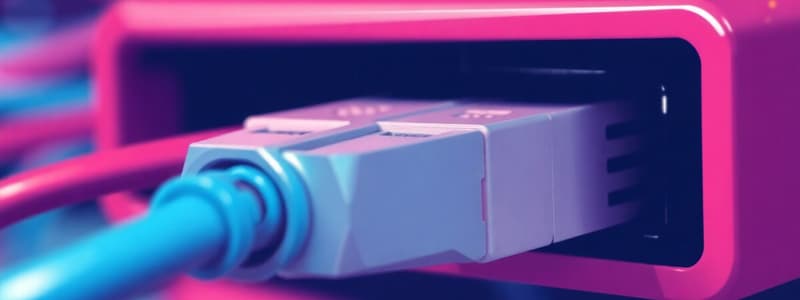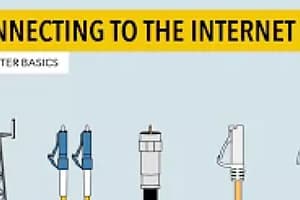Podcast
Questions and Answers
What is a key challenge of satellite internet connectivity?
What is a key challenge of satellite internet connectivity?
- It operates on lower frequencies than terrestrial connections.
- It has consistent and reliable speed without interruptions.
- There can be significant latency in communication. (correct)
- It requires a ground-based cable connection.
What is the typical upload speed for satellite internet mentioned?
What is the typical upload speed for satellite internet mentioned?
- 50 megabits per second
- 20 megabits per second
- 3 megabits per second (correct)
- 250 megabits per second
How does satellite internet mitigate the effects of rain on connectivity?
How does satellite internet mitigate the effects of rain on connectivity?
- By relying on terrestrial connections
- By using specialized routers
- By using line of sight technology (correct)
- By operating at lower frequencies
What is one characteristic of fiber optic internet connections?
What is one characteristic of fiber optic internet connections?
How does the cost of satellite internet compare to terrestrial networking?
How does the cost of satellite internet compare to terrestrial networking?
What latency times does Starlink currently advertise for its service?
What latency times does Starlink currently advertise for its service?
Which of the following statements about satellite connectivity is correct?
Which of the following statements about satellite connectivity is correct?
Which factor affects the reliability of satellite internet during storms?
Which factor affects the reliability of satellite internet during storms?
What is the primary advantage of using fiber optics for internet connections?
What is the primary advantage of using fiber optics for internet connections?
What does the DOCSIS standard stand for?
What does the DOCSIS standard stand for?
Which of the following describes the characteristic of Asymmetric Digital Subscriber Line (ADSL)?
Which of the following describes the characteristic of Asymmetric Digital Subscriber Line (ADSL)?
What limitation affects DSL speed in relation to the Central Office?
What limitation affects DSL speed in relation to the Central Office?
What role does tethering play in mobile internet connectivity?
What role does tethering play in mobile internet connectivity?
How do Wireless Internet Service Providers (WISPs) typically deliver internet to their customers?
How do Wireless Internet Service Providers (WISPs) typically deliver internet to their customers?
What type of technology often accompanies cable broadband services?
What type of technology often accompanies cable broadband services?
What is a common feature of most DSL connections?
What is a common feature of most DSL connections?
What is a disadvantage of using satellite internet connections compared to WISP?
What is a disadvantage of using satellite internet connections compared to WISP?
Which method allows a mobile device to provide internet access to other devices?
Which method allows a mobile device to provide internet access to other devices?
Flashcards
Satellite Networking
Satellite Networking
A type of internet connection using a satellite dish to communicate with a satellite in low Earth orbit.
Non-Terrestrial Communication
Non-Terrestrial Communication
A non-terrestrial communication method, meaning it involves communication with a device in space, like a satellite.
Satellite Latency
Satellite Latency
The time delay experienced in sending data from your device to a satellite and back, typically measured in milliseconds.
Starlink
Starlink
Signup and view all the flashcards
Rain Fade
Rain Fade
Signup and view all the flashcards
Fiber Optic Internet
Fiber Optic Internet
Signup and view all the flashcards
Bandwidth
Bandwidth
Signup and view all the flashcards
Cost of Fiber Optics
Cost of Fiber Optics
Signup and view all the flashcards
Fiber to the Home/Business (FTTH/FTTB)
Fiber to the Home/Business (FTTH/FTTB)
Signup and view all the flashcards
Cable Broadband
Cable Broadband
Signup and view all the flashcards
DOCSIS (Data Over Cable Service Interface Specification)
DOCSIS (Data Over Cable Service Interface Specification)
Signup and view all the flashcards
DSL (Digital Subscriber Line)
DSL (Digital Subscriber Line)
Signup and view all the flashcards
ADSL (Asymmetric Digital Subscriber Line)
ADSL (Asymmetric Digital Subscriber Line)
Signup and view all the flashcards
Tethering
Tethering
Signup and view all the flashcards
WISP (Wireless Internet Service Provider)
WISP (Wireless Internet Service Provider)
Signup and view all the flashcards
Mesh Network
Mesh Network
Signup and view all the flashcards
High-Speed Wireless Network
High-Speed Wireless Network
Signup and view all the flashcards
External/Outdoor Antenna
External/Outdoor Antenna
Signup and view all the flashcards
Study Notes
Internet Connection Types
- Satellite Networking: Uses a satellite dish to communicate with a satellite in low Earth orbit.
- Cost: Typically more expensive than terrestrial connections due to satellite launch costs.
- Speeds: Variable; commonly 50 Mbps down and 3 Mbps up.
- Latency: Higher latency—around 250 milliseconds up/down. Newer technologies like Starlink aim for lower latency (20ms).
- Limitations: Affected by rain fade due to line of sight communication; more complex setup.
Fiber Optic Internet
- Speed: Extremely high bandwidth, ideal for large amounts of data.
- Cost: Generally more expensive due to equipment and repair costs.
- Distance: Enables communication over long distances.
- Use Case: Commonly used in enterprise networks and increasingly for home/business connections to improve bandwidth for sending or receiving information.
Cable Broadband
- Method: Uses existing cable television infrastructure (coaxial cables).
- Broadband: Multiple data streams sent simultaneously across multiple frequencies on a single wire (video, voice, data).
- Technology: Uses the DOCSIS standard (Data Over Cable Service Interface Specification).
- Speeds: High speeds common, often 1 Gbps or higher.
- Convenience: No need for additional cables.
DSL (Digital Subscriber Line)
- Usage: Leverages existing telephone lines.
- Asymmetric: Download speeds often faster than upload speeds (ADSL).
- Speed: Typically 200 Mbps down, 20 Mbps up; limited by distance from Central Office (CO).
- Distance Limitation: Limited range (<10,000 feet) to the CO.
Cellular Internet
- Method: Uses mobile networks (like cell phones).
- Data Transmission: Instead of voice, data is transmitted.
- Tethering: Connects a device to a phone via USB/Bluetooth to use the phone's internet connection.
- Hotspot: Phone enables 802.11 (Wi-Fi) capabilities for other devices to access internet.
Wireless Internet Service Provider (WISP)
- Location: Often in rural areas lacking extensive infrastructure.
- Communication: Sends information to local ground stations instead of space.
- Technology: Uses meshed 802.11, 5G, or proprietary wireless connections.
- Antenna Requirements: Usually requires external/outdoor antennas.
- Speeds: Can reach up to 1 Gbps in some areas.
Studying That Suits You
Use AI to generate personalized quizzes and flashcards to suit your learning preferences.




